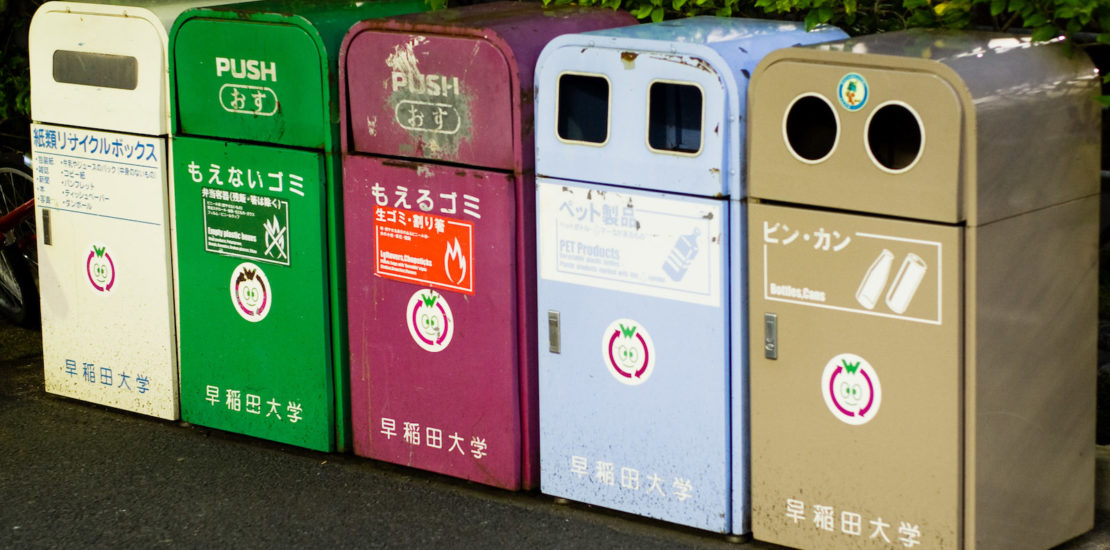In Japan, throwing out your garbage is a systematic process with specific rules which can get very confusing for foreigners who are not used to such strict guidelines.

In Japan your garbage (ゴミ, gomi) is separated into burnable, non-burnables, recyclable, and large-sized garbages. Depending on the city you live in, the collection day, hours, and boxes in which recycled items are placed may differ.
For example: On Monday and Thursdays you throw out your burnable garbage, on Tuesdays your non-burnable, on Wednesdays your recyclables where plastic bottles go in a blue box at the designated garbage disposal in your area.
In this article, I will tell you how to sort and throw out your garbage according to the specific rules and regulations in Japan.
Firstly, every city you may live in will have slightly different garbage disposal regulations. This may seem all very confusing at first, but you will receive an informative packet (usually in poster form) detailing the dates of when to take out your garbage and how to sort your garbage according to the city you live in. If you did not receive such a poster, you can also find a pdf version on the city website or the poster is simply posted by the closest garbage disposal in your area.
Again, depending on the city you live in, you may throw your garbage on specified dates and times, dispose in garbage bags or it will specifically tell you to place certain garbage such as recyclable items in coloured boxes.
Types of Garbage
1. Brunable (もやすゴミ, moyasu gomi)
Burnable garbage includes anything that can be incinerated like kitchen waste, tissues, clothing, wood, videotapes, DVDs, etc.
You must put these garbages in clear bags so collectors can see inside of it. However, be aware of accidentally putting non-burnable items in the same bag, for collectors may not take your garbage.
2. Non-Burnable (もやさないゴミ, moyasenai gomi)
Non-burnable garbage includes metals, glass, hazardous items, non-combustible items, electronic devices, etc.
Depending on the city, plastic items may be marked under this category but are thrown out in separate garbage bags.
3. Recyclable (資源物 , shigenmono)
Recyclables include cardboard, magazines, flyers, newspapers, plastic bottles, reusable glass bottles (must rinsed before disposing), cans, etc. Generally, magazines, newspapers, and cardboard must be stacked and tied in a bundle.
4. Large-sized Garbage (粗大, sodai gomi)
These garbages can include bicycles, household appliances and furniture (in general, items that are over 30cm in length) and are only picked up after you buy a specific sticker and make an appointment. In general, these stickers can cost around ¥200 to ¥1800 depending on the size of the garbage and where you live.
Large-sized garbages requires you to:
- Buy a sticker from your city hall.
- Phone the number written on the sticker and make an appointment.
- Write your name on the sticker and attach it to your garbage.
- Take out the garbage on the specified date.
Throwing out your Garbage
When and where do you exactly throw out your garbage?
Every city has different dates and times of when to dispose of your garbage. Even in the city you live in, neighbourhoods may have different disposal dates and different types of garbage are collected on different dates. That is why it is important to check your disposal guidelines before throwing out your garbage.
Where do we throw our garbage?
Well, depending on the area you live in, there will be a close collection point in your neighbourhood. For example, if you live in an apartment, there may be a room or a dumpster where you can put your garbage in. If you are living in a house, you do not simply place your trash in front of your driveway, but there will be an obvious collecting point where everyone can throw away their garbage.
Although very complex, Japan’s has a very tedious and systematic method of throwing away garbage for eco-friendly purposes. It may be confusing at first, but with the helpful guidelines provided by the city in poster or pdf form, I’m sure everyone will get the hang of it in no time!
Helpful Japanese Vocabularies
- Garbage (ゴミ, Gomi)
- Garbage day (ゴミの日, Gomi no Hi)
- Collection Day (収集日, Shushubi)
- Burnable (もやすゴミ, Moyasu gomi)
- Non-Burnable (もやさないゴミ, Moyasanai gomi)
- Recyclable (資源物, Shigenmono)
- Large-sized Garbage (粗大, Sodai gomi)
Related Articles
Warning: Undefined array key "sfsi_threadsIcon_order" in /home/veremosglobal/tokyoroomfinder.com/public_html/blog/wp-content/plugins/ultimate-social-media-icons/libs/controllers/sfsi_frontpopUp.php on line 165
Warning: Undefined array key "sfsi_blueskyIcon_order" in /home/veremosglobal/tokyoroomfinder.com/public_html/blog/wp-content/plugins/ultimate-social-media-icons/libs/controllers/sfsi_frontpopUp.php on line 170
Warning: Undefined array key "sfsi_bluesky_display" in /home/veremosglobal/tokyoroomfinder.com/public_html/blog/wp-content/plugins/ultimate-social-media-icons/libs/controllers/sfsi_frontpopUp.php on line 266



